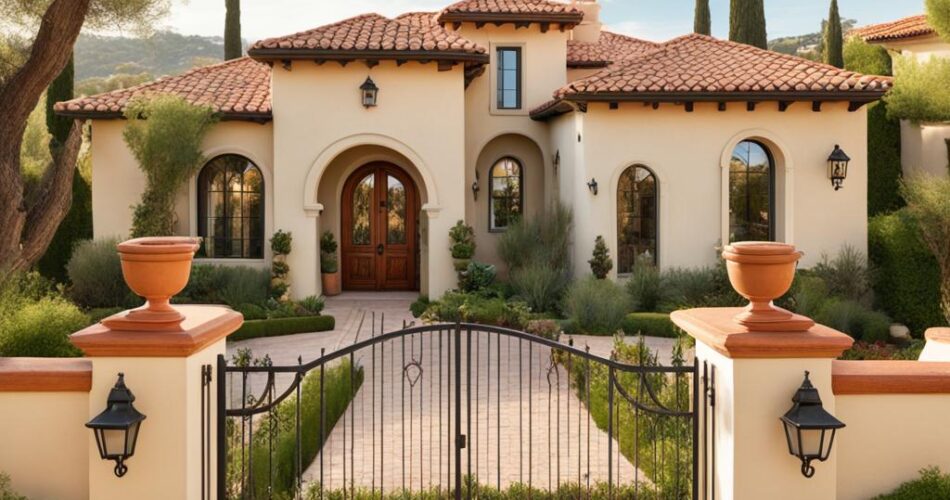From sun-kissed coastal regions, Mediterranean-style homes captivate with rustic charm.
These architectural wonders blend design influences from Italy, Spain, and Greece.
Creating a harmonious fusion, they radiate timeless elegance.
Instantly recognizable by stucco exteriors, terracotta roof tiles, and arched windows.
Mediterranean-style homes exude warmth and tranquility in their interiors.
Graced with courtyards, wrought iron, stone accents, and tiled floors.
Complemented by neutral palettes evoking understated luxury.
Seamlessly integrating outdoor living spaces, reflecting the region’s warm climate.
Serene courtyards and inviting patios beckon residents to embrace nature’s beauty.
Key Takeaways
- Mediterranean-style houses originate from the coastal regions surrounding the Mediterranean Sea, blending architectural influences from Italy, Spain, and Greece.
- Stucco exteriors, terracotta roof tiles, arched windows, interior courtyards, wrought iron details, stone accents, tiled floors, and neutral color palettes are hallmarks of this timeless style.
- Open-air living spaces seamlessly integrate indoor and outdoor areas, reflecting the region’s warm climate and relaxed lifestyle.
- Iconic examples of Mediterranean-style architecture include Villa Vizcaya in Miami and Hearst Castle in San Simeon, California.
- The enduring popularity of Mediterranean-style homes lies in their ability to blend old-world charm with modern functionality.
What is a Mediterranean-Style House?
Mediterranean houses have an architectural style inspired by coastal Mediterranean regions. They blend elements from Italian villas, Spanish haciendas, and Greek homes. These homes are popular in warm areas like California and Florida.
The Mediterranean Revival architectural movement saw a massive rise in the 1920s.
Origins and Influences
The architectural influences come from countries like Spain, Italy, France, Portugal, and Greece. This led to varied Mediterranean styles like Italian Renaissance, Spanish Revival, and Modern Mediterranean.
Key Architectural Elements
Key elements defining Mediterranean houses include stucco exteriors in warm, neutral tones. Red terracotta tile roofs with low pitches are common.
Arched windows and doorways often have wrought-iron details. Interior courtyards or patios blend indoor and outdoor living.
Exposed wooden beams add rustic charm. Warm, earthy color palettes create an inviting ambiance.
- Stucco exteriors with warm, neutral colors like beige, terra cotta, or white
- Red terracotta tile roofs with low pitches
- Arched windows and doorways, often adorned with wrought-iron details
- Interior courtyards or patios that seamlessly blend indoor and outdoor living spaces
- Exposed wooden beams, adding rustic charm and character
- Warm, earthy color palettes that create a welcoming and inviting ambiance
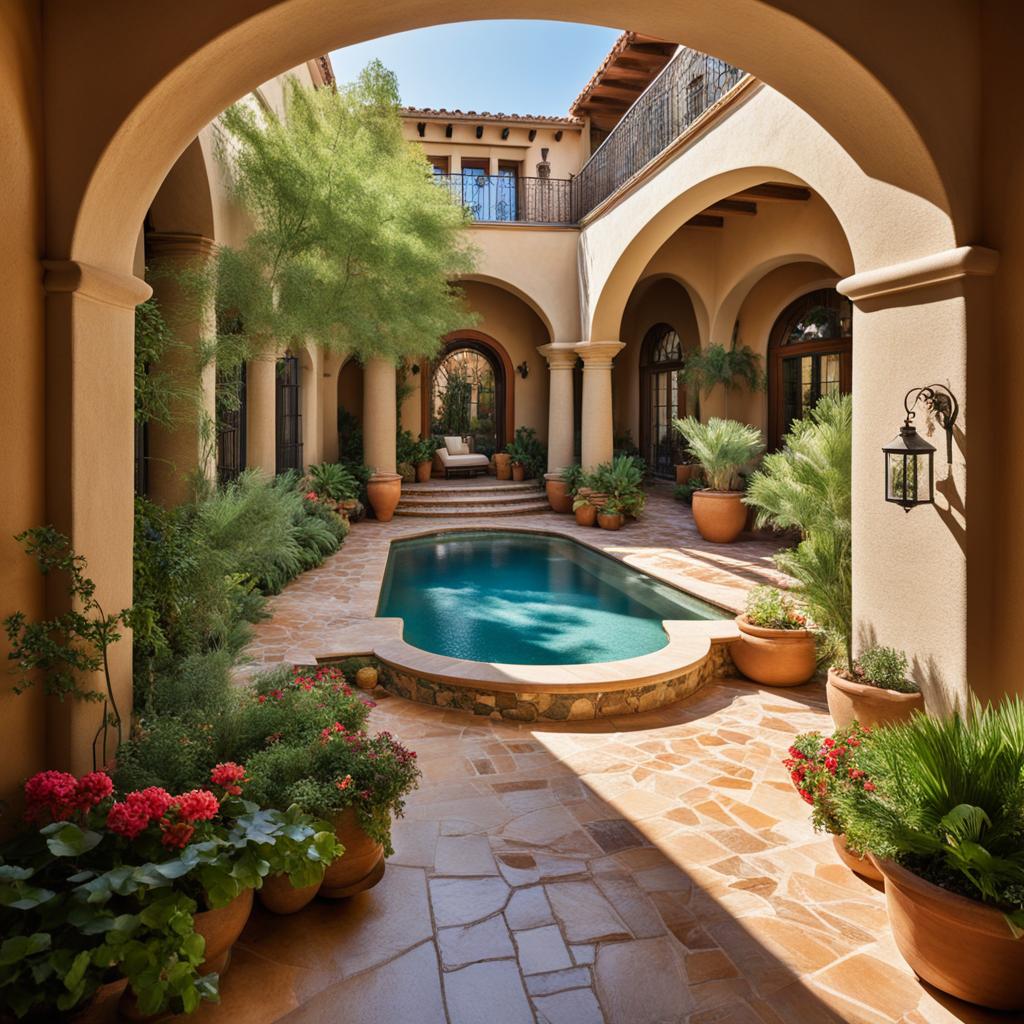
These timeless elements have captivated homeowners, offering rustic elegance tailored to warm climates. From Tuscan villas to Spanish Revival homes, Mediterranean houses exemplify the Mediterranean region’s heritage and lifestyle.
Mediterranean-Style Houses: Exteriors with Enduring Appeal
Mediterranean-style homes exude irresistible charm. They blend terracotta accents, whitewashed walls, and courtyard designs. These residences transport you to sun-drenched Mediterranean shores, evoking timeless elegance and rustic allure.
Stucco Walls and Terracotta Roofs
A defining feature is stucco walls, often warm earthy tones like beige or terra cotta. These whitewashed walls provide stunning visual contrast, keeping interiors cool and comfortable. Quintessential red clay roof tiles crown the homes, with low pitches mirroring the region’s relaxed ambiance.
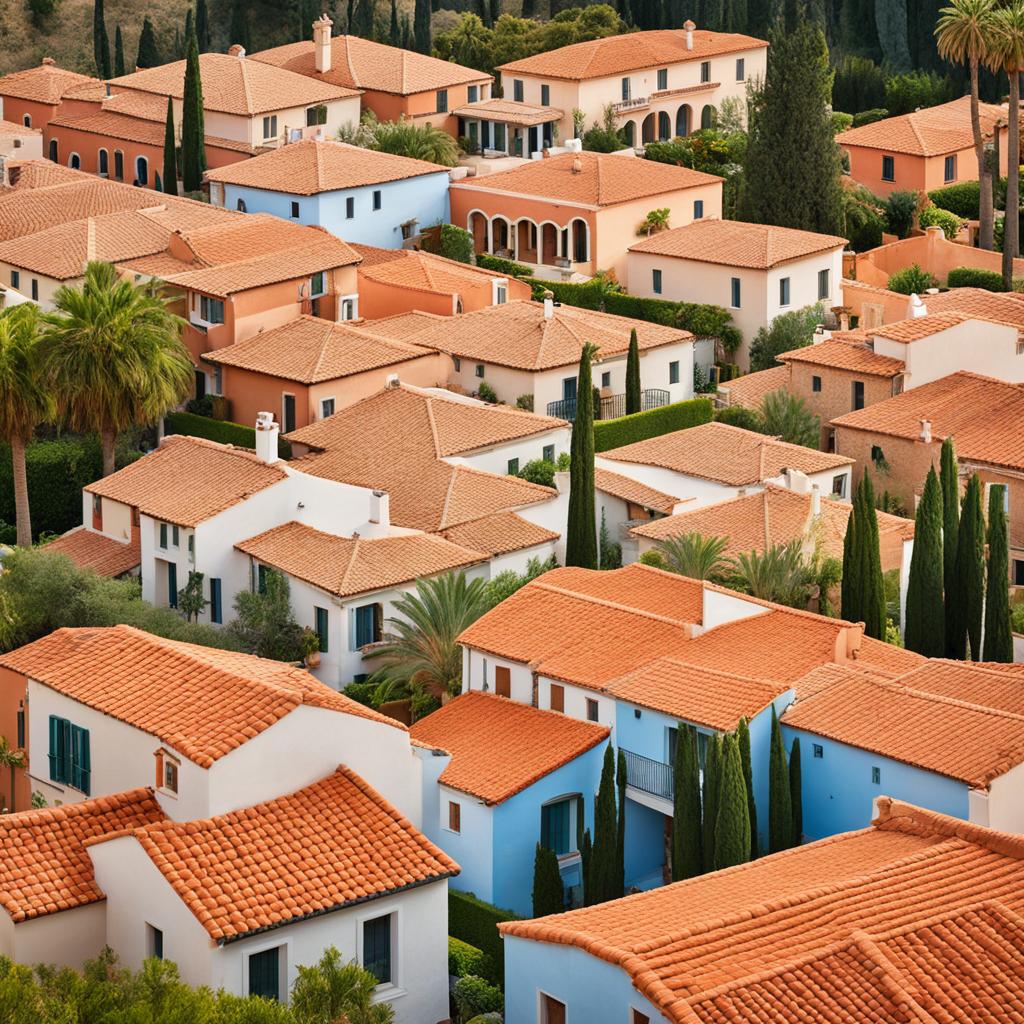
Arched Windows and Doorways
Arched windows and doorways add charm, often adorned with intricate wrought iron details. These architectural elements contribute to open floor plans, inviting natural light to flow seamlessly into interior spaces, creating a welcoming and airy ambiance.
Wrought Iron Accents
Wrought iron accents like balconies, railings, and lighting fixtures add rustic yet elegant ambiance. These intricate details, complemented by lush Mediterranean landscaping, create a true sense of arrival, transporting you to the heart of the region’s rich cultural heritage.
Nestled along sun-kissed shores or tucked in inland oases, Mediterranean-style homes captivate with timeless exteriors. They blend traditional aesthetics with modern sensibilities. From terracotta roofs to arched entryways and wrought iron accents, these residences offer a taste of the Mediterranean lifestyle, inviting you to embrace this enduring architectural style’s beauty and charm.
Inviting Interiors: Embracing Mediterranean Charm
Mediterranean-style interiors harmoniously blend rustic elements and refined sophistication. The design approach seamlessly integrates indoor and outdoor living spaces, reflecting a temperate climate and relaxed coastal lifestyle.
Open Floor Plans and Courtyards
A defining feature of mediterranean home design is the open floor plan flowing effortlessly into interior courtyards or patios. These tranquil spaces blur indoor-outdoor boundaries, inviting natural light and cross-ventilation.
Rooms are thoughtfully arranged around a courtyard, fostering community and togetherness, reminiscent of spanish style homes.
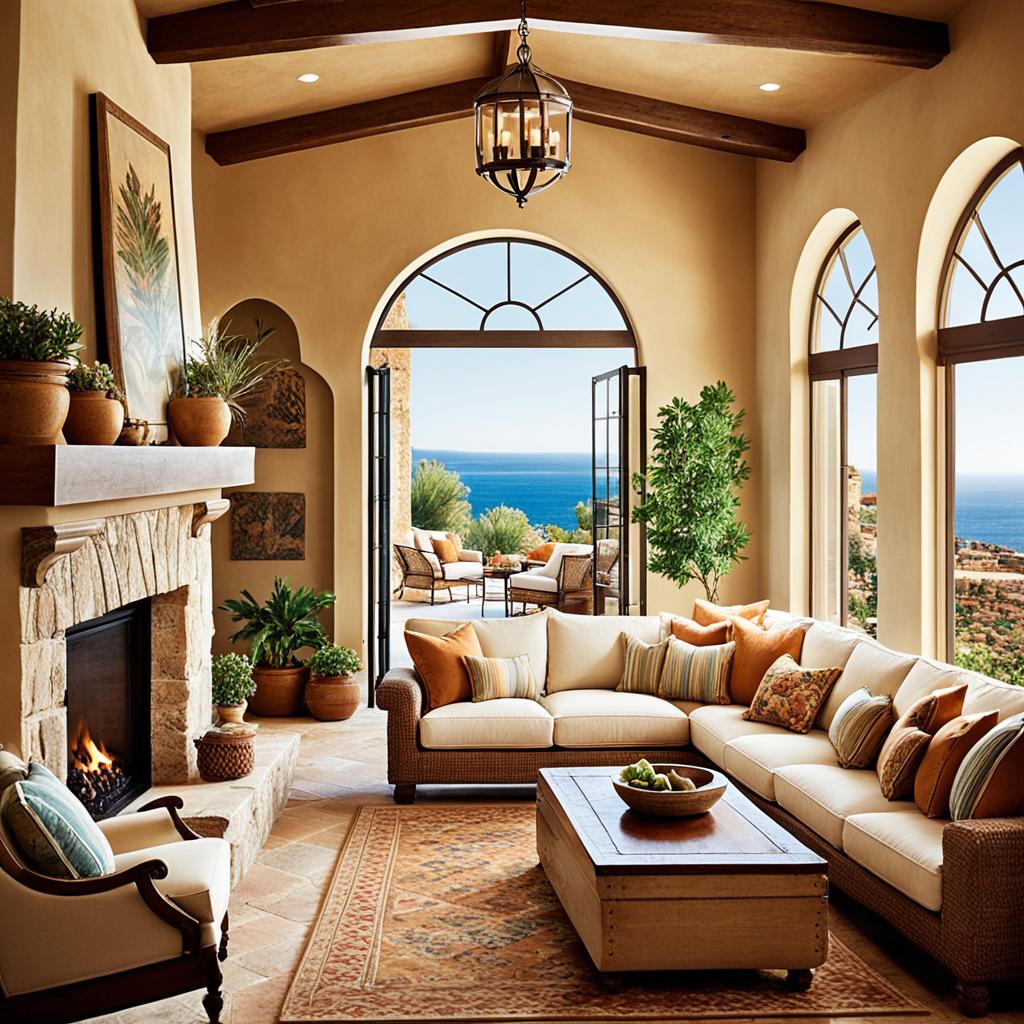
Tiled Floors and Neutral Color Palettes
Tiled floors, often terra cotta or ceramic, lend a rustic yet practical touch. These durable surfaces add warmth, character, and contribute to the coastal aesthetic.
Neutral color palettes, ranging from earthy terra cotta hues to soothing whites and creams, create a calming and inviting ambiance, perfectly complementing the stucco walls and archways.
Architectural details like wrought iron accents, exposed wooden beams, and archways further enhance the coastal Mediterranean influences. These elements blend seamlessly with the neutral color palette, lending rustic elegance.
Mediterranean-style interiors embody the essence of coastal living, where comfort, relaxation, and a connection to nature take center stage.
Iconic Mediterranean-Style House Examples
The Mediterranean architectural style has gained immense popularity across America. Two iconic residences beautifully capture the region’s essence: Villa Vizcaya in Miami and Hearst Castle in San Simeon, California.
Villa Vizcaya in Miami
Built in the early 20th century, Villa Vizcaya showcases Mediterranean Revival architecture and Italian Renaissance design. Its red terra cotta tile roof and stucco walls exude rustic elegance. The ornate wrought iron detailing adds sophistication.
The villa’s indoor-outdoor living spaces, including courtyards and loggias, seamlessly blend interior and lush tropical surroundings.
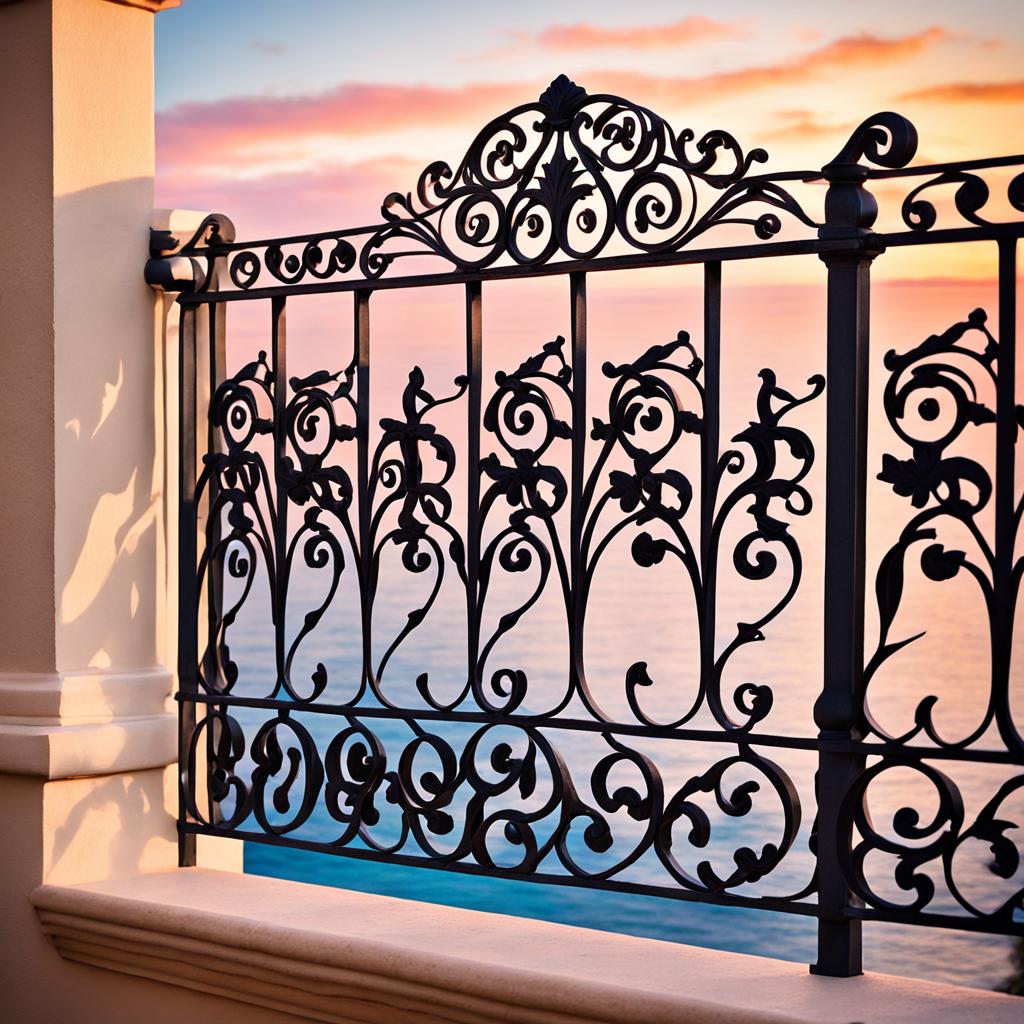
Hearst Castle in San Simeon, California
Hearst Castle, the former residence of William Randolph Hearst, blends Spanish and Mediterranean influences. Designed by Julia Morgan, the castle’s grandeur is evident in its terra cotta tiles, rustic stone accents, and indoor-outdoor living spaces.
The property’s scale and attention to detail, from intricate tile work to luxurious furnishings, showcase the opulence and craftsmanship defining Mediterranean-style architecture.
These two iconic Spanish-style homes exemplify Mediterranean design’s enduring appeal, inspiring generations with their timeless beauty and harmonious integration of natural elements.
| Property | Location | Architectural Style | Notable Features |
|---|---|---|---|
| Villa Vizcaya | Miami, Florida | Mediterranean Revival, Italian Renaissance | Low-pitched terra cotta tile roof, stucco walls, wrought iron details, indoor-outdoor living spaces |
| Hearst Castle | San Simeon, California | Spanish and Mediterranean influences | Terra cotta tiles, rustic stone accents, indoor-outdoor living spaces, grand scale, luxurious furnishings |
Incorporating Mediterranean Elements into Modern Design
Contemporary architecture embraces tuscan-inspired homes‘ timeless allure. Arched windows, doors, stone detailing, and tile mosaics infuse Mediterranean charm into sleek, modern abodes.
For a rustic yet elegant ambiance, Tuscan design elements like exposed wooden beams, terra cotta tiles, and warm color palettes transform ordinary spaces into inviting havens. These Mediterranean-inspired features blend old-world charm with modern functionality, creating sophisticated and comfortable environments.
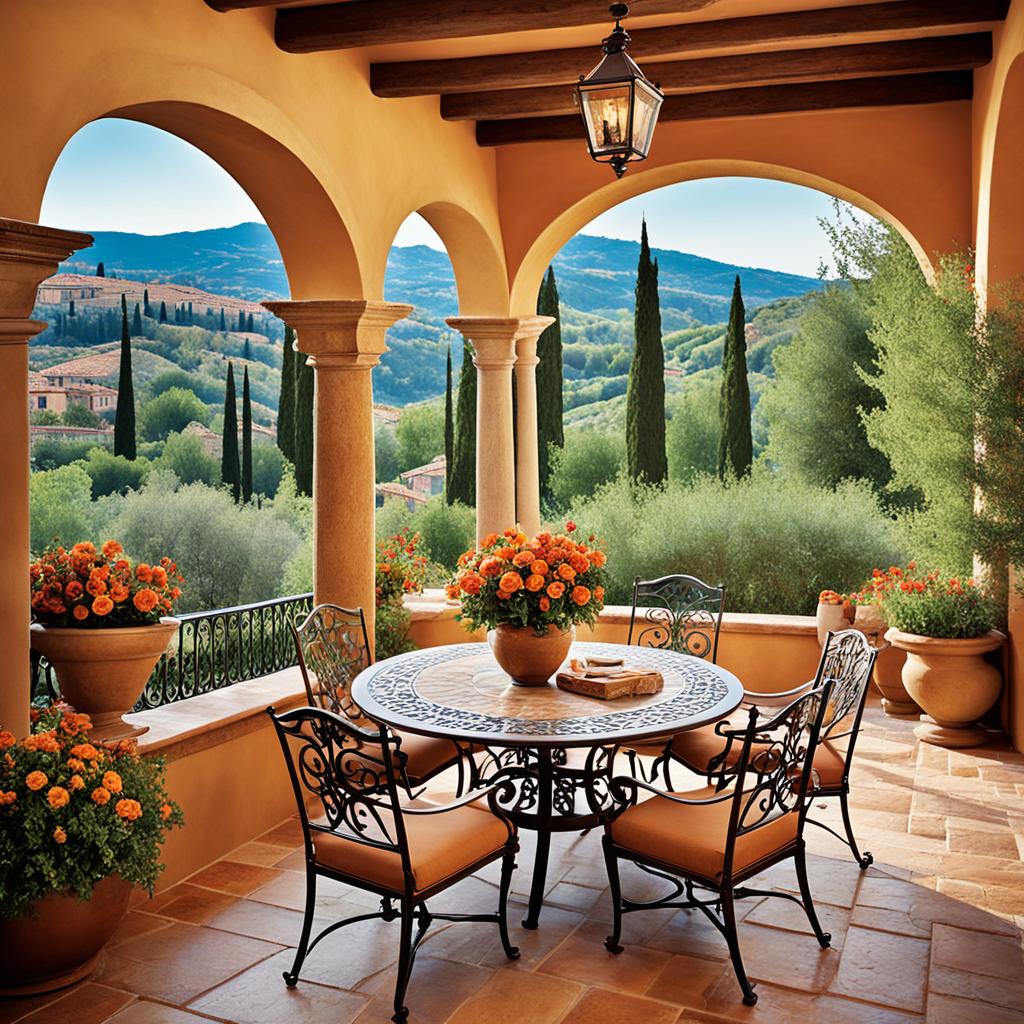
Drawing inspiration from Spanish colonial influences, wrought iron accents and courtyard-style patios merge indoor and outdoor living spaces seamlessly. These elements pay homage to the region’s architectural heritage while promoting the Mediterranean lifestyle of indoor-outdoor living.
For those drawn to Italian villa inspirations‘ grandeur, incorporating arched entryways, stone detailing, and tile mosaics adds Mediterranean opulence. These details can transport you to Italy’s sun-drenched, luxurious villas.
By selectively incorporating Mediterranean elements, homeowners enjoy timeless beauty while embracing modern functionality, creating a harmonious fusion of old-world charm and contemporary living.
Outdoor Living: Embracing the Mediterranean Lifestyle
The Mediterranean lifestyle revolves around outdoor living. Indoor and outdoor spaces blend seamlessly. Homes in this style often have courtyards or patios extending indoor living areas. This creates a harmonious connection with nature.
Courtyards and Patios
Many Mediterranean-style homes feature charming courtyards or patios. These offer serene oases for relaxation and entertainment. Covered patios with terracotta tile roofs provide shaded respite. Fountains and terracotta pottery add decorative tranquil touches.
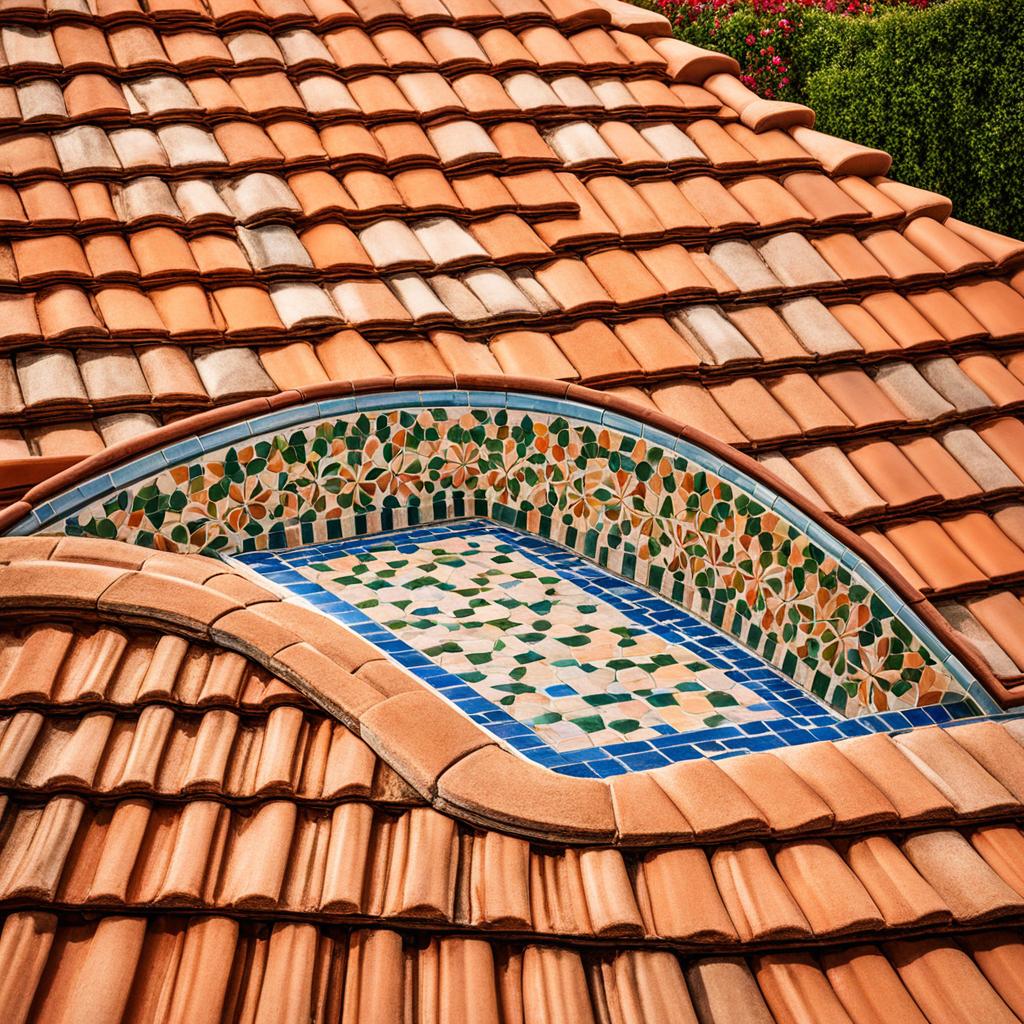
These outdoor living spaces quintessentially blend Tuscan-inspired villas and Spanish revival homes with coastal living design. Whether hosting intimate gatherings or enjoying quiet moments, these spaces connect you seamlessly with the outdoors.
Landscaping with Mediterranean Plants
Landscaping crucially creates a Mediterranean-inspired oasis. Drought-tolerant plants like olive trees, lavender, and cypress evoke the Mediterranean region’s essence. These hardy plants thrive in warm climates. They contribute to the overall aesthetic, creating a lush, inviting outdoor environment.
| Plant | Description | Benefits |
|---|---|---|
| Olive Trees | Evergreen trees with silvery-green foliage and twisted trunks | Drought-tolerant, low maintenance, and symbolize peace and abundance |
| Lavender | Fragrant purple flowering shrubs with delicate blooms | Attracts pollinators, repels insects, and has a calming aroma |
| Cypress | Tall, slender evergreen trees with a pyramidal shape | Provides privacy, wind protection, and a distinctive Mediterranean look |
By incorporating these elements, homeowners truly embrace the Mediterranean lifestyle. The line between inside and outside blurs, and nature’s beauty is celebrated daily.
Mediterranean-Style Homes: Enduring Popularity
Mediterranean-style homes evoke rustic elegance. They blend indoor and outdoor spaces. Arched doorways, earth-toned stucco walls, terracotta roofs define this style.
Spanish villas and Tuscan homes captivate. Their romantic charm makes them perennial favorites. They thrive in warm, temperate climates.
This style blends traditional architecture with modern amenities. Spanish colonial and Italian architecture inspired its foundations. Contemporary interpretations seamlessly integrate open plans, resort-style living.
Mediterranean homes commonly use stucco for construction due to its durability, low maintenance, and fire-resistant properties. Mediterranean homes often feature red clay tile or terracotta roofs that can last for decades and disperse warmth efficiently.
The popularity boomed in 1920s-30s Southern California. Hollywood promoted this architectural style. It resonated with the warm, coastal climate.
- Italian Renaissance-style Mediterranean homes are characterized by larger homes, round arches, columns, stately iron balconies, and decorative brackets.
- Spanish Revival-style Mediterranean homes feature clean lines, unadorned arches above doors, low-pitched roofs, asymmetry, and round or square towers.
Mediterranean homes captivate with timeless appeal. They create a luxurious, inviting atmosphere. Inspired by Italian villas’ grandeur or Spanish villas’ rustic charm.
Customizing Your Mediterranean-Style Dream Home
Bringing timeless Mediterranean charm into your dream home requires careful planning. To truly capture this style’s essence, work with architects and builders specializing in authentic villa designs with courtyard layouts and coastal-inspired interiors.
Your choice of architect and builder plays a pivotal role in realizing your Mediterranean-style vision. Look for professionals deeply understanding the region’s architectural heritage and proven records creating homes blending rustic elements with modern comforts.
A skilled architect will incorporate quintessential Mediterranean features like courtyards, sandstone accents, and tiled flooring while ensuring contemporary living standards. They’ll guide material, finish, and color palette selections authentically capturing Mediterranean warmth and vibrancy.
Balancing Authenticity and Modern Comforts
Designing a Mediterranean-style home challenges striking authenticity and modern comfort balance. Your architect and builder should excel at blending traditional arched doorways, exposed wooden beams, and terracotta tiles with contemporary amenities and functionality.
Vibrant colors and textures can incorporate Mediterranean flair into interior design, while state-of-the-art appliances and smart home technology seamlessly integrate living spaces. Carefully curating these elements creates a home paying homage to Mediterranean architectural heritage while meeting modern living demands.
| Traditional Elements | Modern Comforts |
|---|---|
| Courtyard layouts | Energy-efficient climate control |
| Tiled flooring | Radiant floor heating |
| Rustic stone accents | Smart home automation |
| Exposed wooden beams | Modern kitchen appliances |
By collaborating with professionals understanding Mediterranean design nuances, you can craft a home capturing the region’s enchanting spirit while providing modern living conveniences.
The Timeless Appeal of Mediterranean Architecture
Mediterranean architecture captivates homeowners with old-world charm. The combination of clay roofs, stucco walls, arched windows creates a warm aesthetic.
Mediterranean landscaping enhances the ambiance with drought-tolerant plants. Italian inspirations offer shaded outdoor spaces that blend interiors with exteriors.
Modern Mediterranean homes seamlessly incorporate contemporary amenities while honoring traditional elements.
Blending Old-World Charm with Modern Functionality
Mediterranean-style homes gained widespread appeal in the 1920s. They continue to be popular, well-suited to warm climates.
Exteriors feature warm, neutral colors, stucco walls, clay tiles. These homes stay cool in hot, sunny areas.
Common elements include arched openings, terra-cotta tiles, vibrant landscaping.
Timeless Elegance and Practical Design
Outdoor living spaces play a significant role. Patios and courtyards extend livable square footage.
Mediterranean homes may vary based on influences. But they share stucco walls, red tile roofs.
Spanish revival architecture influenced Mediterranean house plans in the early 20th century.
Blending Indoor and Outdoor Living
Mediterranean house plans prioritize outdoor living spaces. Spacious patios, verandas, and terraces are featured.
Large windows and French doors maximize natural light. Ventilation is also a key design element.
Asymmetrical layouts add unique charm and visual appeal to these homes.
- Spanish revival architecture, a primary influence on Mediterranean house plans, emerged in the early 20th century and gained popularity in regions with a Mediterranean-like climate.
- Mediterranean house plans prioritize outdoor living spaces, featuring spacious patios, verandas, and terraces.
- Mediterranean designs often include large windows and French doors to maximize natural light and ventilation.
- Mediterranean homes with asymmetrical layouts are known for their unique charm and visual appeal.
Designing a Mediterranean-Inspired Interior
When crafting a Mediterranean interior, warm, earthy tones create an inviting ambiance. Natural textures like exposed wooden beams, stone accents, and hand-plastered stucco capture timeless style.
These elements infuse the decor with authenticity and rustic charm.
Color Palettes and Textures
The color palette draws from sun-drenched landscapes. Natural, earthy, and neutral tones feature prominently. Terra-cotta, red clay, burnt umber, and ochre infuse warmth.
Cerulean, azure, and seafoam green evoke tranquility and coastal living.
Organic materials and imperfections create desired textures. Beamed ceilings, wide plank floors, rustic ceramics, and vases add character.
Stucco wall finishes with natural imperfections contribute to an authentic feel.
Furniture and Decor Choices
Rustic, distressed furniture with well-loved patinas align with Mediterranean design principles. Decorative wrought iron, painted/whitewashed wood, and natural stone create cohesion.
Low furnishings with natural fabrics, layered pillows, and rugs add texture.
Arched doorways, tiled floors, and open-air courtyards enhance the Mediterranean aesthetic. These seamlessly blend indoor and outdoor spaces.
Stucco facades, terracotta roofs, and drought-tolerant landscaping complete the cohesive exterior design.
| Material | Color | Texture | Application |
|---|---|---|---|
| Terra-cotta | Warm reds, oranges | Rustic, earthy | Tiles, pottery, roofs |
| Stucco | Beige, white | Textured, imperfect | Wall finishes |
| Wood | Natural, whitewashed | Rough, distressed | Furniture, beams, floors |
| Stone | Earthy tones | Rugged, natural | Accents, flooring |
These elements transport you to sun-drenched Mediterranean shores, where construction embraces old-world charm and modern functionality.
Mediterranean-Style Homes: A Luxury Living Experience
Mediterranean-style homes offer a lavish living experience. They blend old-world charm with modern comforts. These homes often feature open-air patios and courtyards.
Indoor and outdoor spaces merge harmoniously. Warm terracotta colors and rustic textures evoke authenticity. Hand-plastered stucco walls and terra cotta roofing add timelessness.
Inspired by Mediterranean architectural grandeur, these homes showcase elements. Spanish revival style and Tuscan-inspired architecture are prominent. Arched doorways, exposed wooden beams, and wrought iron details contribute.
Mediterranean-style homes provide lavish and inviting atmospheres. They embrace the Mediterranean region’s rich heritage. The relaxed lifestyle is embodied in these residences.
These homes offer spacious, open floor plans. Generous living spaces provide unparalleled luxury living. Distinctive terra-cotta roofs and stucco exteriors require specialized upkeep.
Priority 1 Lending offers mortgage solutions tailored to individuals. Owning a Mediterranean-style home, this luxurious experience, is achievable.
| Region | Mediterranean-Style Homes | Other Architectural Styles |
|---|---|---|
| Dubai (Luxury Homes) | 27% | 73% |
| Palm Beach, Florida (Celebrity Homes) | 38% | 62% |
Mediterranean-style homes significantly feature in affluent regions. Dubai and Palm Beach homeowners embrace the aesthetic. Spanish architecture’s luxury and distinction are sought after.
Conclusion
Mediterranean-style homes captivate architects, builders, and homeowners. They blend old-world charm with modern functionality. Rustic stucco walls and terracotta roofs define them. Elegant arched windows and inviting courtyards embody richness.
Some take inspiration from Spanish colonial haciendas. Others mirror Italian villas’ rustic beauty. Mediterranean homes provide luxurious, inviting living experiences.
Their timeless appeal integrates indoor and outdoor spaces. Tommy Hilfiger’s Palm Beach home showcases this style. A California family home reimagines traditional elements too. The IBIZA Collection celebrates relaxed Mediterranean living.
Spanish courtyard homes and Mediterranean-inspired Florida residences offer the coveted lifestyle. Exposed wood beams provide rustic charm. Ornate archways and wrought iron exude grandeur. These homes continue captivating and inspiring.
